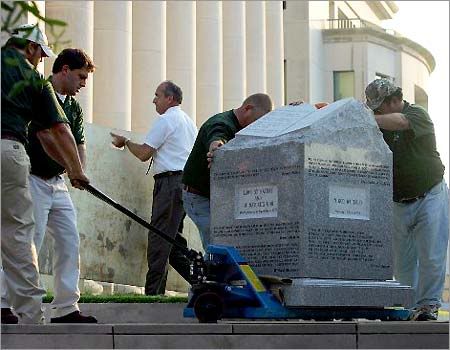The Ten Commandments and The Supreme Court
Well, this has been a very intersting morning.
Listening to the BTK killer (Dennis Rader), who plead guilty to everything, detail the murders he committed at the judge's request. The BTK killer began with dates, locations, and names; but the judge said that wasn't good enough and wanted details. The families of two of the BTK killer's victims are in the courthouse and they are the ones that wanted to know the details of their loved ones' deaths. Closure.
Segue into: Thou Shalt Not Kill
Segue into: The Supreme Court and the Two Rulings Made This Morning
Okay, this kind of ACLU hate propaganda irks the hell out of me. So, I'm listening to FoxNews (Bridget Quinn) and she's relaying the latest from the wires as the rulings come in from Kentucky and Texas. I'm thinking, yeah, yeah, yeah... same old stuff. But, wait a minute... Kentucky - No, but Texas - Yes? What's up with that?
So I Google for the webpage of the Kentucky Courthouse. I want to see what the "historical display" looks like. Being a former resident of Alabama, I was thinking it was along the lines of the granite statue which was in the courthouse in Montgomery. Something prominently displayed. Something massive. Something which called attention to itself. Bridget kept talking about the "addition of other documents on display" and I'm thinking, how can that be? Documents? With a granite statue? So, I find the webpage but it's not looking as though I'll find what I was looking for there, so, back to the Google page and, lo and behold, there's a link to exactly what I want.
Here it is: http://www.lc.org/misc/tencommandphotos.htm

That's it. ???? How in the HELL, if you'll please pardon the unheavenly use of language, is this or could this ever be considered an obtrusive display? I just don't get it. And the deciding vote on the Texas display was by a Liberal judge. It's been there for over forty years so it's okay. Something new, though? Mmmmmmmm, probably won't make it.
I don't understand why the ACLU has such a hard time with this. Who decided they are the ones to scour every nook and cranny for anything they deem prejudiced, biased, or contrary to civil rights? Isn't that self-appointed Big Brothership? I'll decided what is okay for me, thank you. If I disagree with something, and I doubt I'd ever go to the extreme the ACLU does, I'll just walk by. That's all that needs be done. Move along. Shake your head. Nothing else. Now, if it's something completely inappropriate, such as a giant billboard of a couple fornicating which would be easily viewed by children, well, that's gotta go. That's just common sense.
This display in Kentucky is so miniscule, so non-flashy, so quiet and unobtrusive, I doubt I'd even spend time reviewing what was framed. And, if I did, it's certainly not something that's going to get my hackles up.
The news article from FoxNews follows with the official details.
Supreme Court Bars Commandments From Courthouses
Monday, June 27, 2005
By Jane Roh
FoxNews
WASHINGTON — A divided Supreme Court on Monday struck down Ten Commandments displays in two Kentucky courthouses, but said a 6-foot granite replica on government land in Texas was acceptable.
In the first ruling, McCreary County v. ACLU , the court said that the Kentucky displays violated the Establishment Clause of the First Amendment, which prohibits government from endorsing or supporting one religion above others.
The justices ruled 5-4 that the Ten Commandments could not be displayed in court buildings or on government property. However, the Biblical laws could be displayed in an historical context, as they are in a frieze in the Supreme Court building. Notably, the first four commandments, which have to do with honoring God and the Sabbath, were obscured by the artist who designed the frieze.
"The touchstone for our analysis is the principle that the First Amendment mandates government neutrality between religion and religion, and between religion and nonreligion," Justice David H. Souter wrote for the majority.
"When the government acts with the ostensible and predominant purpose of advancing religion, it violates that central Establishment clause value of official religious neutrality," he said.
Souter was joined in his opinion by other members of the liberal bloc — Justices John Paul Stevens, Ruth Bader Ginsburg and Stephen G. Breyer, as well as Reagan appointee Sandra Day O'Connor, who provided the swing vote.
In a dissent, Justice Antonin Scalia argued that Ten Commandments displays are a legitimate tribute to the nation's religious and legal history.
"In the court's view , the impermissible motive was apparent from the initial displays of the Ten Commandments all by themselves: When that occurs: the Court says, a religious object is unmistakable," he wrote. "Surely that cannot be."
"The Commandments have a proper place in our civil history," Scalia wrote. He was joined in his opinion by Chief William H. Rehnquist, as well as Justice Anthony Kennedy and Clarence Thomas.
The Kentucky displays have been the target of litigation since they were first posted in 1999. With each lower court ruling against county officials, revisions were made to the displays. By the time the case landed on the Supreme Court's docket, the framed copies of the commandments were part of a larger, more neutral display about the history of American law.
Scalia wrote in his dissent that the changed displays had become constitutionally acceptable. However, during oral arguments in March, Scalia scolded the county for trying to convince the court the displays had been stripped of religious intent, saying it was "idiotic" to dress the commandments in historical documents such as the Declaration of Independence.
Scalia, Rehnquist and Thomas have all said that there is nothing wrong with government asserting God's supremacy, while the other justices on the court believe doing so would be to the exclusion of Americans of other faiths or no faiths, and is therefore unconstitutional.
Several justices were particularly disturbed by a resolution passed by county officials in reaction to a lower-court ruling, declaring that American law was derived from the Ten Commandments. While revisions were made to the displays, that resolution was left intact.
In the resolution, county officials declared: "The judicial laws of God, as they were delivered by Moses be a rule to all the courts in this jurisdiction."
Monday's rulings were perhaps the court's most highly anticipated of the 2004 session. The court has not visited the hotly contested issue since 1980, when religious displays in public schools were ruled unconstitutional.
 Interest in the cases was boosted by former Alabama Justice Roy Moore's battle two years ago to keep a giant, 5,300-pound granite replica of the commandments in his courthouse. On Nov. 13, 2003, a judicial panel banished him from the bench because he defied a federal court order to remove the tablets.
Interest in the cases was boosted by former Alabama Justice Roy Moore's battle two years ago to keep a giant, 5,300-pound granite replica of the commandments in his courthouse. On Nov. 13, 2003, a judicial panel banished him from the bench because he defied a federal court order to remove the tablets.
The other Ten Commandments case, Van Orden v. Perry , involved a statue donated to the government and placed on grounds outside the state capitol. A Texas court had ruled that the replica, given by the Fraternal Order of Eagles in 1961 and placed among more than a dozen non-religious monuments, did not violate the Establishment clause.
The case was brought by Thomas Van Orden, a former lawyer who is now homeless. Last week, in an interview with the Dallas Morning News, Van Orden predicted the court would rule against him, but said winning or losing was almost beside the point.
"This was never a lawsuit at all," he told the News. "It was always a political question."
The justices, again split 5-4, determined the statue to be a legitimate tribute to the nation's legal and religious history.
"Of course, the Ten Commandments are religious — they were so viewed at their inception and so remain. The monument therefore has religious significance," Chief Justice William H. Rehnquist wrote for the majority.
"Simply having religious content or promoting a message consistent with a religious doctrine does not run afoul of the Establishment clause," he said.
Rehnquist was joined in his opinion by Scalia, and justices Anthony Kennedy and Clarence Thomas. Breyer filed a separate opinion concurring in the result.
Justice John Paul Stevens wrote in his dissent that the display was an improper government endorsement of religion. Stevens noted in large letters the monument proclaims 'I AM the LORD thy God."'
"The sole function of the monument on the grounds of Texas' State Capitol is to display the full text of once version of the Ten Commandments," Stevens wrote.
"The monument is not a work of art and does not refer to any event in the history of the state," Stevens wrote. "The message transmitted by Texas' chosen display is quite plain: This state endorses the divine code of the Judeo-Christian God."
Justices O'Connor, David H. Souter and Ruth Bader Ginsburg also dissented.
The Associated Press contributed to this report.

